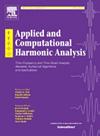Gaussian random fields and monogenic images
IF 3.2
2区 数学
Q1 MATHEMATICS, APPLIED
引用次数: 0
Abstract
In this paper, we focus on lighthouse anisotropic fractional Brownian fields (AFBFs), whose self-similarity depends solely on the so-called Hurst parameter, while anisotropy is revealed through the opening angle of an oriented spectral cone. This fractional field generalizes fractional Brownian motion and models rough natural phenomena. Consequently, estimating the model parameters is a crucial issue for modeling and analyzing real data. This work introduces the representation of AFBFs using the monogenic transform. Combined with a multiscale analysis, the monogenic signal is built from the Riesz transform to extract local orientation and structural information from an image at different scales. We then exploit the monogenic signal to define new estimators of AFBF parameters in the particular case of lighthouse fields. We prove that the estimators of anisotropy and self-similarity index (called the Hurst index) are strongly consistent. We demonstrate that these estimators verify asymptotic normality with explicit variance. We also introduce an estimator of the texture orientation. We propose a numerical scheme for calculating the monogenic representation and strategies for computing the estimators. Numerical results illustrate the performance of these estimators. Regarding Hurst index estimation, estimators based on the monogenic representation of random fields appear to be more robust than those using only the Riesz transform. We show that both estimation methods outperform standard estimation procedures in the isotropic case and provide excellent results for all degrees of anisotropy.
高斯随机场和单基因图像
本文主要研究灯塔各向异性分数布朗场(AFBFs),其自相似性仅取决于所谓的Hurst参数,而各向异性是通过定向光谱锥的开口角度来揭示的。这个分数场推广了分数布朗运动,并模拟了粗糙的自然现象。因此,模型参数的估计是实际数据建模和分析的关键问题。这项工作介绍了使用单基因变换的afbf的表示。结合多尺度分析,利用Riesz变换构建单基因信号,提取不同尺度图像的局部方向和结构信息。然后我们利用单基因信号在灯塔场的特殊情况下定义AFBF参数的新估计器。我们证明了各向异性估计量和自相似指数(称为Hurst指数)是强一致的。我们证明了这些估计验证了具有显式方差的渐近正态性。我们还引入了纹理方向的估计器。我们提出了一种计算单基因表示的数值格式和计算估计量的策略。数值结果说明了这些估计器的性能。对于Hurst指数估计,基于随机场单基因表示的估计器似乎比仅使用Riesz变换的估计器更稳健。研究表明,这两种估计方法在各向同性情况下都优于标准估计程序,并为所有各向异性程度提供了出色的结果。
本文章由计算机程序翻译,如有差异,请以英文原文为准。
求助全文
约1分钟内获得全文
求助全文
来源期刊

Applied and Computational Harmonic Analysis
物理-物理:数学物理
CiteScore
5.40
自引率
4.00%
发文量
67
审稿时长
22.9 weeks
期刊介绍:
Applied and Computational Harmonic Analysis (ACHA) is an interdisciplinary journal that publishes high-quality papers in all areas of mathematical sciences related to the applied and computational aspects of harmonic analysis, with special emphasis on innovative theoretical development, methods, and algorithms, for information processing, manipulation, understanding, and so forth. The objectives of the journal are to chronicle the important publications in the rapidly growing field of data representation and analysis, to stimulate research in relevant interdisciplinary areas, and to provide a common link among mathematical, physical, and life scientists, as well as engineers.
 求助内容:
求助内容: 应助结果提醒方式:
应助结果提醒方式:


